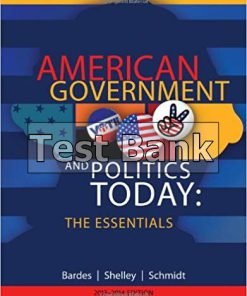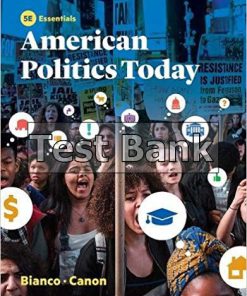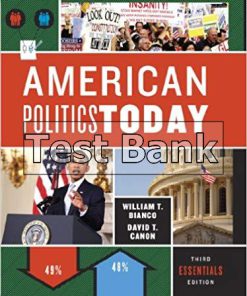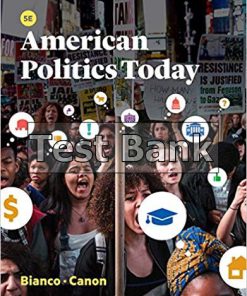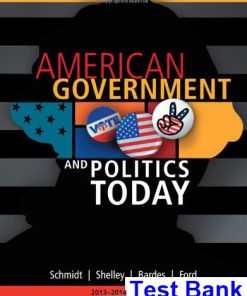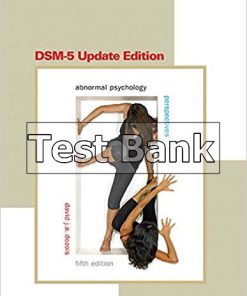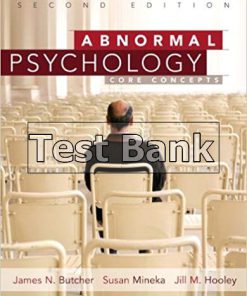American Politics Today Full 4th Edition Bianco Test Bank
You may also like
American Politics Today Full 4th Edition Bianco Test Bank
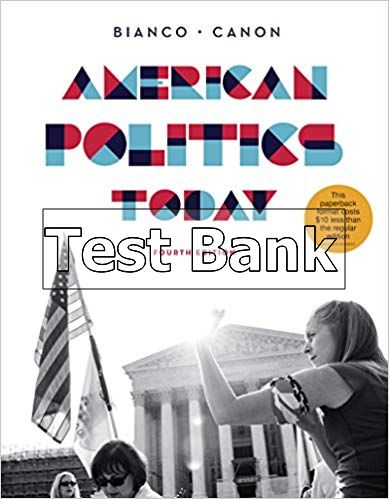
Product details:
- ISBN-10 : 0393906191
- ISBN-13 : 978-0393906196
- Author: William T. Bianco, David T. Canon
The Essentials Fourth Edition of American Politics Today helps students understand the conflicts and compromises inherent in politics and allows them to practice applying that understanding to the debates and controversies they encounter in the news. With combined public opinion and media chapters, and social and economic policy chapters, this edition is jam-packed with pivotal topics that will help students see how institutions and political processes really work.
Table contents:
- PART I: FOUNDATIONS
- 1. UNDERSTANDING AMERICAN POLITICS
- Making Sense of American Government and Politics
- Why Do We Have a Government?
- Forms of Government
- What Is Politics?
- Politics Is Conflictual
- Political Process Matters
- Politics Is Everywhere
- Sources of Conflict in American Politics
- Economic Interests
- Cultural Values
- Racial, Gender, and Ethnic Differences
- Ideology
- Resolving Conflict: Democracy and American Political Values
- Conclusion
- STUDY GUIDE
- 2. THE CONSTITUTION AND THE FOUNDING
- The Historical Context of the Constitution
- The Articles of Confederation: The First Attempt at Government
- Political Theories of the Framers
- Economic Interests
- The Politics of Compromise at the Constitutional Convention
- Majority Rule versus Minority Rights
- Small States versus Large States
- Legislative Power versus Executive Power
- National Power versus State and Local Power
- Slave States versus Nonslave States
- Ratification
- The Antifederalists’ Concerns
- The Federalists’ Strategies
- The Constitution: A Framework for Government
- Exclusive Powers
- Shared Powers
- Negative or Checking Powers
- Is the Constitution a “Living” Document?
- Ambiguity
- Changing the Constitution
- Multiple Interpreters
- Conclusion
- STUDY GUIDE
- 3. FEDERALISM
- What Is Federalism and Why Does It Matter?
- Levels of Government and Their Degrees of Autonomy
- A Comparative Perspective
- Balancing National and State Power in the Constitution
- A Strong National Government
- State Powers and Limits on National Power
- Clauses that Favor Both Perspectives
- The Evolving Concept of Federalism
- The Early Years
- Dual Federalism
- Cooperative Federalism
- Federalism Today
- Cooperative Federalism Lives On: Fiscal Federalism
- The Rise of Coercive Federalism
- The States Fight Back
- Fighting for States’ Rights: The Role of the Modern Supreme Court
- Assessing Federalism
- Ideological Complexities
- Advantages of a Strong Role for the States
- Disadvantages of Too Much State Power
- Conclusion
- STUDY GUIDE
- 4. CIVIL LIBERTIES
- Defining Civil Liberties
- Balancing Interests
- Drawing Lines
- The Origins of Civil Liberties
- Origins of the Bill of Rights
- Selective Incorporation and the Fourteenth Amendment
- Freedom of Religion
- The Establishment Clause and Separation of Church and State
- The Free Exercise Clause
- Freedom of Speech, Assembly, and the Press
- Generally Protected Expression
- Less Protected Speech and Publications
- The Right to Bear Arms
- Law, Order, and the Rights of Criminal Defendants
- The Fourth Amendment: Unreasonable Searches and Seizures
- The Fifth Amendment: Self-Incrimination
- The Sixth Amendment: The Right to Legal Counsel and a Jury Trial
- The Eighth Amendment: Cruel and Unusual Punishment
- Privacy Rights
- Abortion Rights
- Gay Rights
- Conclusion
- STUDY GUIDE
- 5. CIVIL RIGHTS
- The Context of Civil Rights
- African Americans
- Native Americans, Latinos, and Asian Americans
- Women and Civil Rights
- Gays and Lesbians
- A Color-Blind Society?
- The Racial Divide Today
- Differences in Voting Access
- Socioeconomic Indicators
- Criminal Justice and Hate Crimes
- Key Players in the Conflict Over Civil Rights
- The Courts
- Congress
- The President
- Civil Rights Issues Today
- Affirmative Action
- Multicultural Issues
- Conclusion
- STUDY GUIDE
- PART II: POLITICS
- 6. PUBLIC OPINION
- What Is Public Opinion?
- Early Theories of Public Opinion
- Contemporary Theory of Public Opinion
- How People Form Opinions
- Personal Knowledge and Considerations
- Where Do Opinions Come From?
- Socialization: Family and Communities
- Events
- Group Identity
- Politicians and Other Political Actors
- Measuring Public Opinion
- Problems in Measuring Public Opinion
- How Useful Are Surveys?
- Characteristics of American Public Opinion
- Ideological Polarization
- Evaluations of Government and Officeholders
- Policy Preferences
- Does Public Opinion Matter?
- Public Opinion Is Relevant
- Public Opinion Can Influence Government
- Conclusion
- STUDY GUIDE
- 7. THE MEDIA
- The News Media in America
- Historical Overview
- Media Sources
- Political Reporting: Sources, Leaks, and Shield Laws
- Staging the News
- Revealing Sources
- How Do Americans Use the Media to Learn about Politics?
- Does the Source Matter?
- Media Effects on American Citizens and Government Policy
- Theories of Media Influence
- Assessing Media Coverage of American Politics
- Media Bias
- Where Else Does Media Coverage Fall Short?
- The Effect of Market Forces
- Conclusion
- STUDY GUIDE
- 8. POLITICAL PARTIES
- What Are Political Parties?
- History of American Political Parties
- The Evolution of American Political Parties
- Realignments
- Modern American Political Parties
- The Party Organization
- The Party in Government
- The Party in the Electorate
- The Role of Political Parties in American Politics
- Organizing Elections
- Cooperation in Government
- Minor Parties
- Effects on Election Outcomes
- Unique Issues Facing Minor Parties
- What Kind of Democracy Do American Political Parties Create?
- Recruiting Good Candidates
- Working Together in Campaigns
- Working Together in Office
- Providing Accountability
- Citizens’ Behavior
- Conclusion
- STUDY GUIDE
- 9. ELECTIONS
- How Do American Elections Work?
- Functions of Elections
- Two Stages of Elections
- Constituencies: Who Chooses Representatives?
- Presidential Elections
- Electoral Campaigns
- Setting the Stage
- Before the Campaign
- The General Election Campaign
- Campaign Advertising: Getting the Word Out
- Campaign Finance
- How Do Voters Decide?
- The Decision to Vote
- How Do People Vote?
- Voting in Normal and Nationalized Elections
- Understanding the 2014 Election
- The Path to 2014: The 2010 and 2012 Elections
- Analyzing the 2014 Elections
- Conclusion
- STUDY GUIDE
- 10. INTEREST GROUPS
- The Interest Group Universe
- The Business of Lobbying
- Organizational Structures
- Staff
- Membership
- Resources
- Getting Organized
- The Logic of Collective Action
- Interest Group Strategies
- Inside Strategies
- Outside Strategies
- Choosing Strategies
- How Much Power Do Interest Groups Have?
- What Determines When Interest Groups Succeed?
- How Groups Succeed
- Conclusion
- STUDY GUIDE
- PART III: INSTITUTIONS
- 11. CONGRESS
- Congress’s Place in Our Constitutional System
- Congress and the People
- Representation and the Constituency
- The Electoral Connection
- Redistricting
- Congress’s Image Problem
- The Incumbency Advantage and Its Sources
- In the District: Home Style
- Campaign Fund-Raising
- Constituency Service
- The Structure of Congress
- Informal Structures
- Formal Structures
- How a Bill Becomes a Law
- The Conventional Process
- Deviations From the Conventional Process
- Differences in the House and Senate Legislative Processes
- Oversight
- Congressional Reform
- Conclusion
- STUDY GUIDE
- 12. THE PRESIDENCY
- Presidential Power: Yesterday and Today
- Early Years through World War I
- The Great Depression through the Present
- The President’s Job Description
- Head of the Executive Branch
- The President as Politician
- Presidential Succession
- The Executive Branch
- The Executive Office of the President
- The Vice President
- The President’s Cabinet
- The American Public and the President
- Gauging Presidential Popularity
- Explaining Presidential Approval
- Assessing Presidential Power
- Presidents and Unilateral Action
- Control over the Interpretation and Implementation of Laws
- Congressional Responses to Unilateral Action
- Conclusion
- STUDY GUIDE
- 13. THE BUREAUCRACY
- What Is the Federal Bureaucracy?
- What Do Bureaucrats Do?
- Bureaucratic Expertise and Its Consequences
- How Has the American Bureaucracy Grown?
- The Beginning of America’s Bureaucracy
- Building a New American State: The Progressive Era
- The New Deal, the Great Society, and the Reagan Revolution
- The Modern Federal Bureaucracy
- The Structure of the Federal Government
- The Size of the Federal Government
- The Human Face of the Bureaucracy
- Civil Service Regulations
- Limits on Political Activity
- Political Appointees and the Senior Executive Service
- Controlling the Bureaucracy
- Agency Organization
- Monitoring
- Correcting Violations
- The Consequences of Control
- Conclusion
- STUDY GUIDE
- 14. THE COURTS
- The Development of an Independent and Powerful Federal Judiciary
- The Founders’ Views of the Courts: The Weakest Branch?
- Judicial Review and Marbury v. Madison
- Judicial Review in Practice
- The American Legal and Judicial System
- Court Fundamentals
- Structure of the Court and Federalism
- How Judges Are Selected
- Access to the Supreme Court
- The Court’s Workload
- Rules of Access
- The Court’s Criteria
- Internal Politics
- Hearing Cases before the Supreme Court
- Briefs
- Oral Argument
- Conference
- Opinion Writing
- Supreme Court Decision Making
- Legal Factors
- Political Factors
- The Role of the Court as a Policy Maker
- Compliance and Implementation
- Relations with the Other Branches
- Conclusion
- STUDY GUIDE
- PART IV: POLICY
- 15. ECONOMIC POLICY
- Goals of Economic Policy
- Full Employment
- Stable Prices
- Promote the Free Market and Growth
- Balanced Budgets
- Balance of Payments, or the Current Account
- Trade-offs between Economic Goals
- The Key Players in Economic Policy Making
- Congress
- The President
- The Bureaucracy
- How Economic Policy Makers Interact: The 2008 Economic Crisis
- Tools and Theories of Economic Policy
- Fiscal Policy
- Monetary Policy
- Regulatory Policy
- Trade Policy and the Balance of Payments
- The Politics of Trade Policy
- Conclusion
- STUDY GUIDE
- 16. SOCIAL POLICY
- The History and Background of Social Policy
- Poverty and Income Inequality
- The Key Players in Social Policy Making
- Congress and the President
- The Bureaucracy
- The States
- Interest Groups
- The Policy-Making Process
- Social Policy Today
- Social Security
- Health Care
- Income Support and Welfare
- Education
- Conclusion
- STUDY GUIDE
- 17. FOREIGN POLICY
- What Is Foreign Policy?
- Foreign Policy Principles and Perspectives
- History of American Foreign Policy
- Foreign Policy Makers
- The President and the Executive Branch
- Congress
- The Federal Courts
- Groups outside the Federal Government
- The Tools of Foreign Policy
- Diplomacy
- Trade and Economic Policies
- Foreign Aid
- Alliances and Treaties
- Military Force
- The Politics of Foreign Policy Today
- Managing International Trade: China
- Fighting Terrorism: Afghanistan
- Preventing the Spread of Weapons of Mass Destruction: North Korea
- Conclusion
- STUDY GUIDE
- APPENDIX
- The Declaration of Independence
- The Articles of Confederation
- The Constitution of the United States of America
- Amendments to the Constitution
- The Federalist Papers
- Glossary
- Credits
- Index
People also search:
american politics today full 4th edition
american politics today (full 7th edition pdf free)
american politics today 5th edition pdf free download
american politics today 5th edition pdf
american politics today 5e pdf

